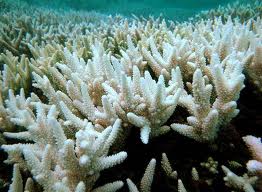 Eco Brooklyn hasn’t done any marine work. Our water related experience so far has been with rainwater run-off, ponds, natural pools and gray water. But one thing we have kept an eye on is coral, since it is a key indicator of what to expect ecologically.
Eco Brooklyn hasn’t done any marine work. Our water related experience so far has been with rainwater run-off, ponds, natural pools and gray water. But one thing we have kept an eye on is coral, since it is a key indicator of what to expect ecologically.
Our planet has already warmed up by almost 10C. When we hear this we normally just associate it to the air temperature since this is relative to all of us living on land. Global warming also interferes with natural temperature cycles of sea water, which can be detrimental to all of the organisms that call fresh water and the oceans home especially corals which are sensitive to the smallest changes.
Corals are cnidarians that are host to dinoflagellate symbionts called zooxanthellae. These zooxanthellae live in the endoderm (the inside) of the animal and are the main food supply for the organism; they also allow the animal to build a calcareous skeleton.
 Through elevated temperature experiments done on the Aiptasia, that is a zooxanthellea hosting anemone, it has been determined that the host animals cells are programmed to kill its’ zooxanthellea symbionts to protect itself if temperatures change noticeably.
Through elevated temperature experiments done on the Aiptasia, that is a zooxanthellea hosting anemone, it has been determined that the host animals cells are programmed to kill its’ zooxanthellea symbionts to protect itself if temperatures change noticeably.
This causes the corals to take on a pale or white color hence the name coral bleaching. After prolonged periods of exposure to elevated temperatures the cells go through necrosis. However the animal is still able to recover from these events if they don’t last for longer than about a month.
Reports have been shown that in recent year’s coral reefs around the world are going through greater periods of coral bleaching where just 50 years ago this would be rare occurrences. 1998 was one of the hottest years recorded and bleaching of corals were recorded in 60 countries and affected corals up to 50m in depth. This is significant in that is shows that cooler deeper waters are becoming warmer. Normally corals that are bleached reside around 15m in depth.
 In the past when reefs experienced bleaching events the reef would be able to allow for the cloned zooxanthellae to reproduce asexually to a healthy population within the host. Now that global temperatures are increasing and higher water temperatures are sustained for longer periods of time; it becomes harder for these organisms to recover.
In the past when reefs experienced bleaching events the reef would be able to allow for the cloned zooxanthellae to reproduce asexually to a healthy population within the host. Now that global temperatures are increasing and higher water temperatures are sustained for longer periods of time; it becomes harder for these organisms to recover.
Reports have shown that 90% of the animals eventually die from bleaching since it lost its primary food supply. It’s not conclusive that global warming is the cause of this but is becoming increasingly harder to deny every year.
We as a society are becoming more aware of our actions on our environment and are trying to make a difference. Some, like Bill McKibben in his book Eaarth (link to http://www.billmckibben.com/eaarth/eaarthbook.html) would say that we have done too much for too long and nothing we can do now will stop the spiral of global warming.
Eco Brooklyn tends to agree. Our green building actions are all geared towards what you could call, “Aging gracefully.” We don’t have hopes of stopping it but that doesn’t mean we are marching off to the old peoples’ home. Through close monitoring of key indicators like coral, and through sustained green building practices we hope to weather the storm as effectively as possible.
We at Eco Brooklyn understand that green building is an important part in making these changes. Something as small as a brownstone green roof may not change the world but it certainly improves the comfort and peace of those who live in that home. And for those people it means the world.
Saf K.
